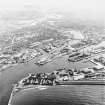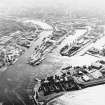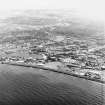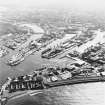Aberdeen Harbour, River Dee Dock
Dock (Period Unassigned), Quay (Period Unassigned)
Site Name Aberdeen Harbour, River Dee Dock
Classification Dock (Period Unassigned), Quay (Period Unassigned)
Alternative Name(s) Maitland's Quay
Canmore ID 104098
Site Number NJ90NE 7.08
NGR NJ 9522 0537
NGR Description Centred NJ 9522 0537
Datum OSGB36 - NGR
Permalink http://canmore.org.uk/site/104098
- Council Aberdeen, City Of
- Parish Aberdeen
- Former Region Grampian
- Former District City Of Aberdeen
- Former County Aberdeenshire
NJ90NE 7.08 centred 9522 0537
Field Visit (24 April 2008)
NJ 9522 0538 (centred on) This assessment was based on a desk-based assessment and a walkover survey of the entire area of the proposed redevelopment of the River Dee Dock and environs. Work was carried out on 24 April 2008.
The Dee formed the S boundary of Aberdeenshire until the early 20th century. Facing it on the S bank were
Kincardineshire and the riverside burgh of Torry. Torry received a charter in 1495 as a burgh of barony held by
the Bishop of Arbroath. Despite this, it failed to thrive, no doubt greatly overshadowed by the already established and prosperous neighbouring burgh of Aberdeen. However, a pier was constructed in 1611–1612. By the 18th century one of the two principal landowners was the burgh of Aberdeen. The 1st Edition OS 1:10560 map of 1868 shows Torry as a fishing village, in which industrial development was beginning. The map shows a brickworks SW of the village.
The Victorian period saw great changes, including the diversion of the River Dee in the 1870s. This destroyed most of the old settlement of Torry, and in 1891 the City of Aberdeen absorbed its southern neighbour as well as its northern one.
Urbanisation was in progress by 1902, with a new harbour and quay, streets, and a school and church to serve the growing population. 25 years later, the River Dee Dock and Maitlands Quay had been established, together with a marine laboratory, shipbuilding yards and sawmills. These developments almost completely destroyed the remains of the old Torry village. However, the biggest alterations occurred after WW2, with large municipal housing schemes filling the previously open area S of Victoria Road.
Torry is now integrated into the larger city, with a modern urban industrial and residential landscape. Apart from late 19th to 20th-century industrial archaeology there is no visible surface evidence of the area’s history. To the S open land remains at Tullos and despite recent use as a landfill site Bronze Age archaeology survives.
The archaeological sites in the development vary considerably and include findspots through to 20th-century
industrial archaeology. We identified 30 sites, 14 previously identified sites and 16 additional ones, during the walkover survey.
This assessment has attempted to develop the necessary knowledge of the site and its wider context, to consider its cultural significance and all phases of its development, and to ensure that where possible features and artefacts are preserved in situ with a minimum degree of intervention. Where this cannot be achieved they will be fully recorded.
NJ 9522 0537 River Dee Dock (NJ90NE 7.08), 20th century. This was constructed 1909–1915 and includes
integrated structural elements of the Maitlands and Mearns Quays, including the Cross Berth. This is presently intact.
Cait McCullagh and John Wood (Highland Archaeology Services Ltd), 2008


















